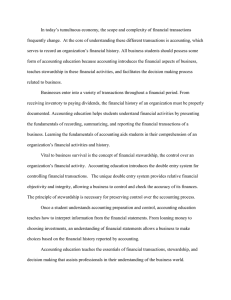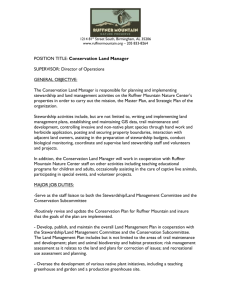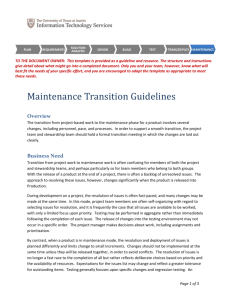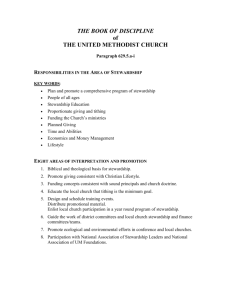Policy brief The Georgia Water Stewardship Act 2010 Required Actions by State Agencies
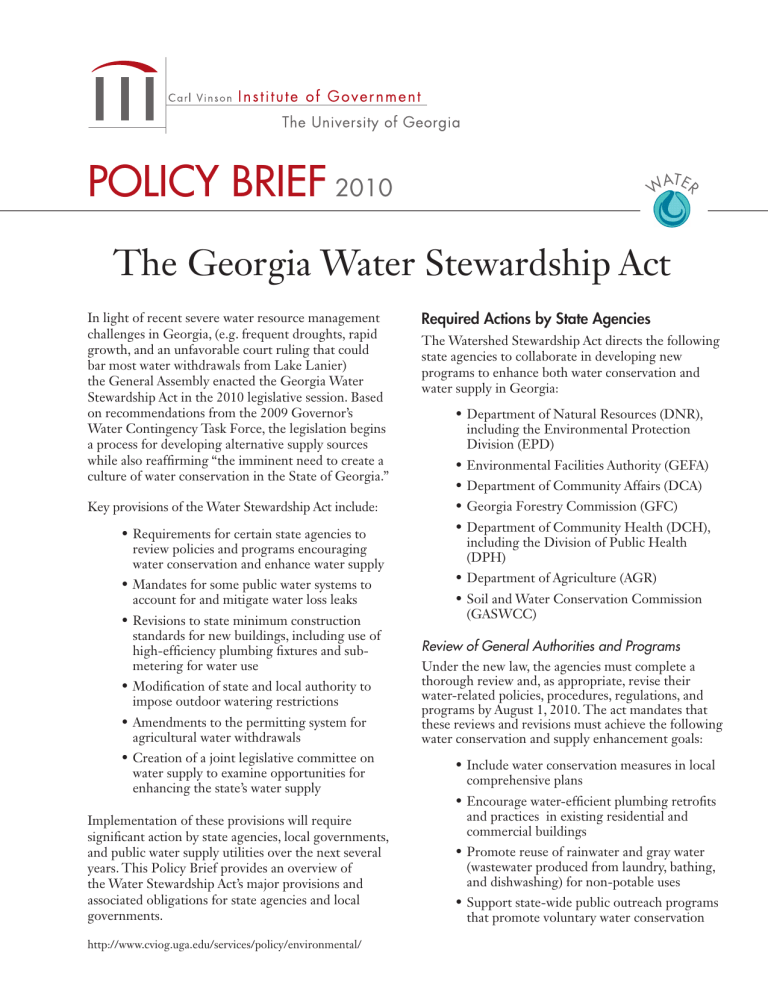
Policy brief
2010
W
A T E
R
The Georgia Water Stewardship Act
In light of recent severe water resource management challenges in Georgia, (e.g. frequent droughts, rapid growth, and an unfavorable court ruling that could bar most water withdrawals from Lake Lanier) the General Assembly enacted the Georgia Water
Stewardship Act in the 2010 legislative session. Based on recommendations from the 2009 Governor’s
Water Contingency Task Force, the legislation begins a process for developing alternative supply sources while also reaffirming “the imminent need to create a culture of water conservation in the State of Georgia.”
Key provisions of the Water Stewardship Act include:
• Requirements for certain state agencies to review policies and programs encouraging water conservation and enhance water supply
• Mandates for some public water systems to account for and mitigate water loss leaks
• Revisions to state minimum construction standards for new buildings, including use of high-efficiency plumbing fixtures and submetering for water use
• Modification of state and local authority to impose outdoor watering restrictions
• Amendments to the permitting system for agricultural water withdrawals
• Creation of a joint legislative committee on water supply to examine opportunities for enhancing the state’s water supply
Implementation of these provisions will require significant action by state agencies, local governments, and public water supply utilities over the next several years. This Policy Brief provides an overview of the Water Stewardship Act’s major provisions and associated obligations for state agencies and local governments.
http://www.cviog.uga.edu/services/policy/environmental/
Required Actions by State Agencies
The Watershed Stewardship Act directs the following state agencies to collaborate in developing new programs to enhance both water conservation and water supply in Georgia:
• Department of Natural Resources (DNR), including the Environmental Protection
Division (EPD)
• Environmental Facilities Authority (GEFA)
• Department of Community Affairs (DCA)
• Georgia Forestry Commission (GFC)
• Department of Community Health (DCH), including the Division of Public Health
(DPH)
• Department of Agriculture (AGR)
• Soil and Water Conservation Commission
(GASWCC)
Review of General Authorities and Programs
Under the new law, the agencies must complete a thorough review and, as appropriate, revise their water-related policies, procedures, regulations, and programs by August 1, 2010. The act mandates that these reviews and revisions must achieve the following water conservation and supply enhancement goals:
• Include water conservation measures in local comprehensive plans
• Encourage water-efficient plumbing retrofits and practices in existing residential and commercial buildings
• Promote reuse of rainwater and gray water
(wastewater produced from laundry, bathing, and dishwashing) for non-potable uses
• Support state-wide public outreach programs that promote voluntary water conservation
The Georgia Water Stewardship Act | CVIOG Policy Brief | 2
• Examine the financial impacts of conservation on water utilities and water users
• Provide incentives for public water systems to implement conservation pricing and full cost accounting, as well as assist those systems in reducing water losses associated with system leakage
• Conduct feasibility studies and obtain appropriate funds for reservoir dredging and other water supply enhancement measures
Beginning January 1, 2011 and continuing through
January 1, 2015, the agencies must submit annual reports that describe implemented program changes, goals for further encouraging water conservation, and plans for further enhancing the state’s water supply.
Required Actions by Local Governments
The Water Stewardship Act substantially revises local government authority for establishing outdoor watering restrictions, and includes amendments to the state minimum standard plumbing code for new construction projects.
Outdoor Watering Restrictions
Before January 1, 2011, local governments must adopt or amend their ordinances to restrict outdoor irrigation using publicly supplied water to the hours between 4 P.M. and 10 A.M. The time restrictions for outdoor irrigation do not apply to the use of any water obtained from private wells, or from reuse water sources such as cooling system condensate, storm water, gray water, and reclaimed wastewater.
The following uses are also exempted from the time restrictions:
• Commercial agricultural and horticultural operations
• Turf on athletic fields, golf courses, and other public recreation areas
• Turf being planted and established through hydro-seeding techniques
• Newly installed plants, seeds, or turf during a
30-day establishment period after the initial planting date
• Personal food gardens
• Drip and soaker hose irrigation systems
• Hand watering with a hose that has an automatic cutoff nozzle, or with hand-held containers
• Irrigation system installation, repair, or calibration
The Water Stewardship Act extends previous requirements for local governments to obtain approval from EPD for more stringent outdoor watering restrictions, but specifies that such approval must now be obtained for stricter limitations during non-drought periods as well. The Act authorizes the director of EPD to take enforcement actions against local governments not in compliance with state water use policy.
Plumbing Codes
The Water Stewardship Act amends the state minimum standard plumbing code for water use by plumbing fixtures installed in new construction granted a building permit after July 1, 2012. These specifications provide that:
• Toilets, whether dual flush or single flush, must not exceed an average of 1.28 gallons per flush
• Water-based urinals must not exceed 0.5 gallons per flush
• Showerheads must have a flow of less than 2.5 gallons per minute
• Bathroom faucets must have a flow of less than 1.5 gallons per minute
• Kitchen faucets must have a flow of less than
2.0 gallons per minute
Sub-metering
Property owners have traditionally measured water use in many multi-unit buildings (such as apartments, office buildings, and light industrial facilities) through centralized meters for the entire building. The use and total costs are divided among the building tenant using an allocation formula. By contrast, sub-metering provides a system in which water use in each unit is directly measured and each tenant is billed for their use.
To provide greater awareness of personal water use and an incentive to reduce that use, the Water
Stewardship Act requires sub-metering of each new multi-unit residential building and certain retail and light industrial buildings granted a permit for construction after July 1, 2012.Tenants in these new buildings are to be charged for water and wastewater use based on the measured usage. Installation of sub-meters is also encouraged, but not mandated, in http://www.cviog.uga.edu/services/policy/environmental/
The Georgia Water Stewardship Act | CVIOG Policy Brief | 3 existing multi-unit buildings and for any office components of newly constructed multi-unit buildings. Local government ordinances will need to be consistent with these new requirements.
Air Conditioner Cooling Towers
The Act requires DCA to develop new state standards requiring installation of high efficiency cooling towers in certain new construction granted building permits after
July 1, 2012. The agency must establish the standards using guidelines of the American Society of Heating,
Refrigerating, and Air-Conditioning Engineers. Local government ordinances will need to be consistent with these new requirements.
Required Action by Public Water Systems
As water providers for much of Georgia’s population, the public water system operators will be involved with implementing many aspects of the Water Stewardship Act.
The act contains specific requirements for public water systems with regard to water loss audits and the allowable fees that can be levied for installation of sub-meters. water systems are prohibited from levying any additional installation or use fees for privately owned sub-meters that are maintained by property owners in existing or newly constructed multi-unit buildings. However, an appropriate installation and/or user fee may be imposed for sub-meters owned, operated, and maintained by the public water system.
Conclusion
The Water Stewardship Act is intended to demonstrate
Georgia’s deep commitment to the conservation of critical freshwater supplies. Given the context of multistate negotiations over the allocation of water resources and the potential return of severe drought conditions, it is incumbent upon Georgia’s state agencies and local governments to implement the new law’s provisions in a timely and efficient manner. Effective planning and cooperation towards these ends will help to ensure that the Georgia’s water supply system can sustainably meet the needs of economic development in the state, while also maintaining adequate flows that satisfy the needs of downstream users in both Georgia and its neighboring states.
Water Loss Audits
Before January 1, 2011, the Board of Natural Resources must establish a best practices program to improve water use efficiency and water conservation by public water systems serving at least 3,300 individuals. This program will include requirements for annual water loss audits and a water loss detection program, as well as a technical assistance component. Requirements will be phased in based on the size of public water systems. Public water systems serving 10,000 or more people must conduct a water loss audit by January 1, 2012. All other public water systems in the program have to complete an audit by
January 1, 2013. Systems will submit results from all water loss audits to EPD within 60 days of completion, and the agency will post the results on its website.
Sub-metering
As noted above, the Water Stewardship Act includes a submetering requirement for all multi-unit residential, retail, and light industrial buildings granted construction permits after July 1, 2012. Sub-meters are also encouraged as a voluntary addition to existing multi-unit buildings or newly constructed multi-unit office buildings.
The act distinguishes between privately and publicly owned equipment when discussing fees associated with the installation and use of sub-meters. Specifically, public
May 2010 http://www.cviog.uga.edu/services/policy/environmental/

